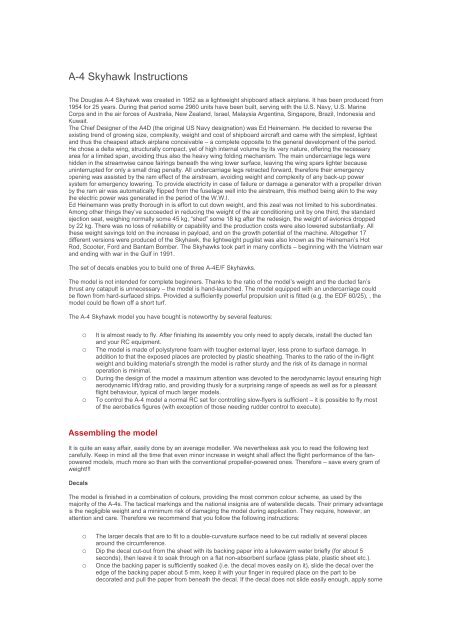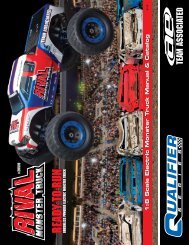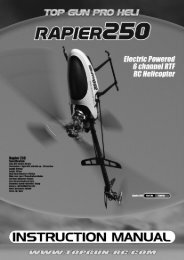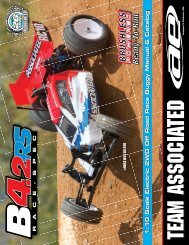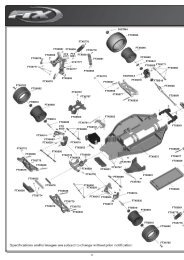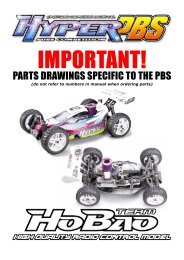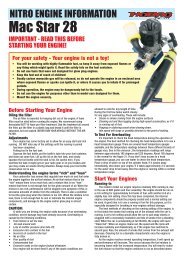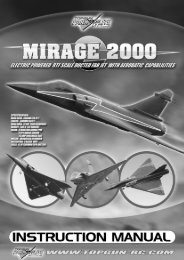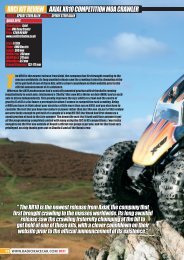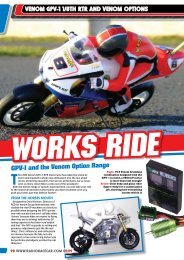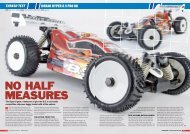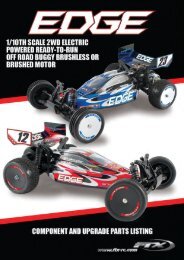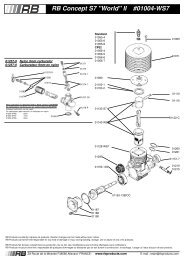A4 Skyhawk Instructions - CML Distribution
A4 Skyhawk Instructions - CML Distribution
A4 Skyhawk Instructions - CML Distribution
- No tags were found...
You also want an ePaper? Increase the reach of your titles
YUMPU automatically turns print PDFs into web optimized ePapers that Google loves.
more water around it with a paintbrush; it would help you to loosen and replace the wrongly-applied decal,too.o Using a soft cloth or, rather a polyurethane foam roller, carefully smooth out the decal, gently squeezingthe excess glue and any air bubbles from the centre to its outer edges. Do not squeeze out all of the glue!Do not force the decal to follow every detail when still wet - once the glue dries, i.e. in a few hours, thedecals would shrink somewhat and adhere snugly to the surface.o To increase the adhesion of the decals, try to use the setting solution used for the plastic scale kit decals.Check beforehand whether the solution does not etch the extruded polystyrene and then follow theattached instruction for use. If you presume to change the decals/livery of the model later on, thisprocedure is not suitable. Use the wallpaper glue instead, as, following a thorough soaking with water, thedecals will be much easier to remove. However, ensure in advance that glue would not create blotches orlumps when it dries – this is why the white (PVA) glues are usually not suitable.o The model could be oversprayed with a thin layer of transparent gloss acrylic or synthetic varnish to suityour ideas regarding the surface finish of the real aeroplane. It is absolutely necessary to checkbeforehand on a scrap piece of polystyrene from the kit that the varnish does not attack the polystyrenefoam. To keep the weight down, spray varnish very sparingly.A) Assembling the power unitThe model is propelled by the Alfa Model EDF 60/15 Mk.2 ducted fan. This ducted fan is designed for the Speed300/6V motor and/or for AC motors with similar performance characteristics ( MP Jet 25-25/26 Mk.2/Mk.3, MM1215/12, Mega 16/7/4(3), Hacker B20 22S). The batteries and controllers are listed in the survey of therecommended powerplants. The model flies well even with the Speed 300/6V motor, but count with a limited life ofthis motor, as it has to run at currents around 9 Amperes. The AC motors are better suited for the propulsion of thefan – their shaft is more solidly supported in the bearings and some are even dynamically balanced. Both these factsmarkedly influence the total performance of the fan; also their operational life is much longer than with the “Speed”type of the DC motor.The performance of the model could be markedly enhanced by using the EDF 60/25 fan, differing from the EDF60/15 Mk.2 only by the rotor. For powering the EDF 60/25 fan it is necessary to use an AC motor of a minimumoutput of 200 W (e.g. a Mega 16/7/4 or a 16/7/5) and properly sized batteries and controller. In any case themaximum recommended weight has to be strictly adhered to. Also the proper cooling of the controller is mandatory –a suggested was making an air intake slit of 2 x 20 mm size in the intake ducting at the location of the controller – theslit would serve to extract the hot air from the vicinity of controller, or, to use a more powerful controller (around 35A),that would stand the higher operating temperature.The motor is centred in the fan core by its (motor’s) circumference. Inside the core tube there are wide and narrowribs. The narrow ones are there to support the Speed 300 motor, the wider ones are for the MPJet 25-25/26 motor.To install the MPJ 25-25/26 motor, it is necessary to cut short the narrow ribs, using a knife, a chisel or a sandpaper(sanding block), without damaging the wide ones. If need be to use a motor of even smaller diameter (such as theMM1215/12), it would be necessary to install taller longerons, gluing them to the inside of the motor casing walls. Thediameter of the Mega motor 16/17 requires a marked enlargement of the opening in the motor casing. Therefore it ispreferable to use the version made from the outset for the installation of the Mega motor, including the plug. As theouter diameter of the motor casing varies slightly due to manufacturing tolerances, it may be necessary to sand(ream) inside of the fan core tube carefully to ensure the motor a good fit.The duraluminium plug of the fan is either pressed (Speed 300 with the splined shaft end) or glued onto the motorshaft. The correct relative position of the plug and the motor’s drive shaft is one of the deciding factors affecting thecorrect operation of the fan. If the plug would wobble, it would vibrate the fan rotor, too, leading to a pronounceddecrease of rpm and therefore to a big loss of thrust. Also the front bearing of the motor would suffer a failure soon,indeed. Therefore ensure that the plug and the shaft would be exactly coaxial when pressing them together, alsoproviding that all the forces would be supported by the shaft itself and the plug, not by the motor body. It is prudent tooil lightly the shaft and the plug before pressing, too. Conversely, when gluing the plug to the shaft, remove any traceof grease from the shaft and the plug; some roughening of the shaft with very fine sandpaper would not do any harm,either. If the diameter of the shaft of the motor you are going to use is greater than the diameter of the hole in theplug, it is necessary to drill (ream) the plug hole. Using a series of drill bits with diameters growing in 0,1 mmincrements, and a fair measure of patience and care, it is possible to do it by hand; without a lathe. Once reamed, theplug could be also glued to the splined shaft of the Speed 300/6V motor. For the eventual disassembly this method isbetter than pressing the plug on.The gap between the motor outer shell and the rotor should be about 0,5 to 1 millimetre. If screws are used to attachthe motor to the core, it is mandatory to check that the rotor does not bind on their heads. Even if the recessed-headscrews would be used, the distance between the plug and the motor front plate must not be less than 3,5 mm. To setthe distance (gap) properly, it is advisable to use a scrap of balsa plank or of a polystyrene sheet of suitablethickness (about 1,8 mm, depending on the size of the bearing box, it has to be checked); slide on the motor shaftonce the “tight” hole in the back plate is drilled. This “gap gauge” ensures a proper position of the plug on the shaftduring the gluing, also preventing glue from eventual getting into the front bearing. Apply a small amount of the glueincluded in the kit both into the plug hole and to the end of the shaft. Insert the shaft into the plug. Turning it, spreadthe glue on the whole inside surface of the hole and leave the whole assembly aside in a vertical position to dry fora minimum of 30 minutes. Once the glue dries, remove (gouge out) the “gap gauge” shim between the motor and theplug. At the low motor rpm, you can check both mechanically and (or) optically, whether the plug wobbles or not.During the optical check, observe how much the reflection of the light oscillates on the rotating plug. During themechanical check, touch the rotating plug very lightly by the ball of finger or a fingernail - do not push! Eventual
shall be accessible only through the installation opening in the fuselage. The same opening would serve foraccess to changes in the aileron control circuit.o Insert the joiner 2 into the hole in the single servo arm; the distance of the hole to the rotational axis shouldbe about 8 mm (Fig. C1). If the opening in the servo arm of your servo is too large, it is better to drill a newhole nearby (of 1 mm diameter), than to try to line the existing hole. Cut off the end of the arm protrudingpast the joiner.o Insert a piece of tubing 3, about 10 mm long, into the opening in the joiner.o Attach the arm and joiner to the servo.o Glue the servo into the wing, using PU or Epoxy glue. The rotational axis of the servo arm should lie in theaxis of the wing ad the tube 3 in the axis of the push-pull rods. The servo could be raised by gluing asbalsa beam between the servo and the bottom wing skin. (Fig.C1).o Remove the servo arm, slide the joiner 2 with the tube 3 in place first on one a push-pull rod , then on theother rod, and install the arm back on the servo. The axis of the arm should lie in the axis of the wing.o Tighter the bolt 4 lightly so that the ailerons’ trailing edges would lie either directly aligned with the wingtrailing edges or would be positioned slightly up.o The maximum aileron throw should be about 6 mm up and 5 mm down (Fig.C2). This effect could beachieved only by limiting the servo throw at the transmitter. Decreasing the length of the servo arm isunadvisable, the as the play in the control circuit would grow considerably.o Secure the joiner 2 from an accidental disconnection by sliding the elastic washer 5 from below (the servoarm is away from the model; the optimum tool would be a tube such as the ball point pen refill lead) andsecure also the servo arm by screwing on the screw 6. Set the ailerons again into the correct position andtighten the screw 4. Secure the control push-pull rods against accidental disconnection by gluing (CA)a piece of thin tubing in pace as per (Fig.C3).o The joiner could be secured from an accidental disconnection with a piece of thin tubing, glued in place ofthe elastic washer 5. If glued well, the thin tube should serve as a safety very well; if need be, thedisassembly would be much simpler indeed- the tube would need just to be cut away...o Glue (Epoxy) the wing 1 to the fuselage 7. Do not cut away the access hatch of the fuselage beforeattaching the wing – the fuselage would lose its rigidity!!! Check that the wing is perpendicular to thefuselage. The wing has to be glued well also to the bottom fuselage fairing overlapping to the wing.D) FuselageWhen removing the cockpit canopy 8, lift its rear edge held in place by magnets (Fig.D1). Slide the canopybackwards so as to disengage the front lock. When putting the canopy back, use the same sequence in reversedorder.The access hatch is, already from the manufacturer, attached to the rest of the fuselage by a self-adhesive tape. Onthe left (port) side, in the narrow gap between the fuselage proper and the hatch, cut through the adhesive tape. – thehatch could be swung open that way. To close the hatch again, you can tack-glue its free edge to the fuselage usinga PU glue – if need be, this joint could be opened again after a cut with a razor blade. Another possibility is to, oncethe decals are applied, and thoroughly dry, wrap a thin clear (transparent) self-adhesive tape longitudinally so that itwould wrap the edge and adhere to both outer and inner surface of the hatch. The hatch then could be held in closedposition by other piece(s) of the self-adhesive tape without danger of damaging the paint or plastic when removingthe tape.The fan air duct consists of three parts (Fig.D2). The front one is firmly joined with the lateral air intakes and with thefuselage. The middle section 9 consists of two parts and it has to be removed every time, with the exception of theaccess to the elevator servo. The exhaust duct is connected to the fan casing 10.o Into the holes marked in the bulkhead cut the threads by screwing in place the screws 11 for attachment ofthe propulsion unit – working in the empty space of the still-unequipped fuselage is considerably easierthan in the fully outfitted one.o Slide the exhaust duct 10 onto the fan casing – using a piece of self-adhesive tape attach the duct to thefan casing.o Insert the fan and exhaust duct through the motor bulkhead. Thread the motor feed cables through the cutoutin the right (stbd.) lower corner of the bulkhead. Ensure that the rear edge of the exhaust duct shouldtightly fit along its complete circumference (with exception of the fin area, indeed) with the inner walls of thefuselage– it has to just touch them and must not be bulged (pushed inside) by anything. The required fitwould be reached by sliding the duct on the casing tube of the fan. Once the proper position would befound, attach the exhaust duct to the fan casing by an adhesive tape along the complete circumference.o Attach the fan to the bulkhead by three screws 11.o Insert the halves of the middle section 9, one at a time, into the fuselage. The wider end forward, therecessed end to the rear, toward the fan. To facilitate the installation, insert the parts using the longerdiagonal of the hatch opening and the free space between the front of the duct and the fuselage side walls.Align both halves and attach with self-adhesive tape as per Fig.D3, which shows the tape by the dashedline. First attach the centre tape, then rotate the ducting and attach the lateral ones and then as the lastones seal the longitudinal joints. Move the tube forward so that any play in the joint would be eliminatedand secure with the self-adhesive tape to the front of the intake ducting. For parts removal, applya reversed procedure. Install the central section of the duct only after the model is completely outfitted.
E) Attachment of the horizontal tail, elevator controlo In the vertical fin, cut a groove for the joiner 12. It is advised to cut the groove narrower and sand to fit asnecessary , so that the joiner 12 was perpendicular to the vertical longitudinal plane of the fuselage .o Glue (Epoxy) the joiner 12 into the groove.o Glue (Epoxy, PU, UHU Por) both halves of the horizontal tail (13 and 14) to the joiner 12. Note!!! On theinner surfaces of the empennage the UHU Por glue is already applied. If you press them together, they willbe stuck together. To unglue them you would need benzine (test first on a scrap of plastic!!).o Apply the glue on the joiner from both sides, slide the horizontal tail on the joiner and press so that theywould be glued evenly on the full surface of the joiner. The trailing edge of the horizontal tail (or rather, theelevator) registers with the trailing edge of the rudder.For the rudder control a servo having a torque of 7 Ncm or more is suitable.o Insert a joiner 2 to the hole in a single arm of a servo, at a distance of some 8 mm from the rotary axis(Fig.E1). If need be, drill a new hole. Into the connector opening insert a piece of plastic tubing 15 some10 mm long. Slide this assembly onto the control push-pull rods and attach the control arm to the servo sothat its axis would be about perpendicular to the axis of the axis of the elevator control rods.o The lengthwise position of the servo is given by the width of the servo you have used. The servo should lieas close to the rear edge of the installation opening. There must, however, remain a small gap between theservo and the middle section of the exhaust duct, enabling to install the duct 9 (Fig.E1). According to theresulting position of the servo shorten the push-pull rods and their tubes.o Use such an installation height of the servo that the servo arm with the joiner would move outside of thefuselage and air duct walls. Glue the servo to the fuselage wall (UHU Por, Epoxy) and stiffen the wall bygluing in place a strip 16 immediately beneath the servo (Fig.E1).o Glue (Epoxy, PU) the tubes of the control push-pull rods to the fuselage walls. If the distance of the servoto the rear edge of the installation opening bigger, it is advisable to increase the stiffness of the control rodouter tubes by their gluing together (CA), or even by adding a balsa support strip to them.o Lightly tighten the screw 4 of the joiner – the servo arm and both halves of the elevator are in neutralposition.o Check that the maximum throw of the servo corresponds to the elevator throw of about 10 mm at thetrailing edge (Fig.E2) – ensure the proper sense of deflections according to the movement of sticks! Onlythen secure the connector 2 against accidental disconnection by an elastic washer 5 slid from below (theservo arm is outside of the model) or by gluing a piece of thin tubing, the servo arm by screwing in thescrew 17. Set the elevator halves to a correct position and tighten the screw 4. Secure the push-pull controlrods against accidental disconnection at the elevator control horn by gluing to it a piece of thin tubing(Fig.E3).F) Completing the modelPlace the controller and receiver as needed for balancing the model. The recommended position of the receiver is atthe left (port) wing side in front of the motor bulkhead, with the antenna led to the belly of the fuselage. The properplace for the controller is on the right (stbd.) fuselage side, the leads to the batteries are threaded through an openingabove the intake duct into the cockpit. In any case it is important that the power wires are kept as far as possible formthe receiver. If sliding of the accumulator battery to the vicinity of the intake ducting is necessary, it is advisable toprevent a damage to the ducting by gluing a balsa partition to limit the space available for the movement for theaccumulator battery. The controller, receiver and the accumulator battery as well are all attached by a self-adhesivebackedVelcro strip.Glue the completed and painted pilot figurine into the cockpit, or stiffen the canopy by a crosswise brace.The required position of the centre of gravity is marked by lines moulded on the wing underside (Fig.F). The model,supported in this place on the fingers should remain either in a horizontal position or should slightly dip the nose.G) Test flying the modelBalance the complete assembled model by shifting the battery in the tray. For the first flights the position of the CGcould be moved as much as 5 mm forward, but in no case backwards! Mark the correct position of battery on the tray(better done at leisure at home), as well as the check of the RC equipment – i.e. the correct sense of the movementand the deflection of ailerons and elevator and the operation of the controller. If your RC equipment allows for that,set the exponential deflections of ailerons and elevator to 60%.When launching the model, hold it behind the wing at the main bulkhead. It is important that the model flies straight,not pitching or yawing (rotating around the horizontal or vertical axis). If you can have a help from a moreexperienced modeller at least for the first flights, do not hesitate to ask him!Due to the wing loading it is useless to test-glide such a model. Give the model full throttle, and hand-launch it atsome 10° up into a shallow climb. When you fit a weaker power unit, the model would in all probability “sag” slightlybut it will still remain fully controllable both by the ailerons and elevator. The more powerful power plants will ensurethat the model will continue straight in the direction of the launch. The reaction of the A-4 <strong>Skyhawk</strong> model to changesin thrust are neutral and the controlling it is easy, provided the recommended values for weight, control deflections
and centre of gravity position were observed. When flying, always keep in mind some specific characteristics of thedelta wing. One of them is the comparatively steep increase of drag at higher angles of attack, showing itselfespecially in tight turns. Yet even in these turns the machine shows quite docile and benign stall behaviour. The deltawing shows a quite low damping along the longitudinal axis – both mass and aerodynamic. This may show especiallyduring stronger gusts and crosswind as a certain twitchiness of the model along its longitudinal axis. .The A-4 manages easily all aerobatic figures with the exception of those that need the rudder control. There is noneed to be afraid of flying inverted, of stalls and spins – for the recovery from them it suffices to push the elevatordown. The model offers a surprisingly large range of speeds. There is no problem flying to the wind speeds of up to 5m/s. When going for a landing, always bear in mind that the landing sped is much slower than the maximum one.It is necessary to bear in mind that the fan characteristics are completely different from the propeller’s ones.Especially at slow speeds the propeller-driven model are able to accelerate much more rapidly that the fan-drivenones. The fan-propelled models also lack the effects of the energetic propeller slipstream over the empennage, whichmay help in some critical situations.When flying the <strong>Skyhawk</strong> model with the powerful fan, a special danger may show – which calls for a constantattention. The model is quite small and not so well “readable” at greater distances. Yet, at the maximum speed it may“disappear” into the visibility-critical distance quite fast. In such case please immediately reduce throttle, start to climband try to establish the actual position of the model.Due to the low-wing layout it is advisable to fly at the prepared surfaces. The low–set wing is easily damaged whenlanding out. Equipping the model with undercarriage, which is almost invisible, will allow you to take-off and land onprepared surfaces. Installing the undercarriage is simple – the shapes of all components are described in theinstructions, the places where to install the legs are marked on the appropriate locations on the model airframe.Do not expose the model and its power unit to the sunlight for long periods of time, especially behind a window ofcar.We wish you many a happy landing.ALFA MODELA list of parts and tools necessary for finishing the model that are not supplied in the kit:o UHU Por, polyurethane (PU) glue, five-minute Epoxy glue, cyanoacrylate (CA) glue.o Modelling knife, screwdrivers, 1mm drill bit, transparent self-adhesive tape.o Motor, speed controller, battery pack – some of the tested recommended combinations are listed bellow.o At least a three-channel RC set with two micro servos (up to 10 g weight) and a miniature receiver (up to10 g weight).o Battery charger.


